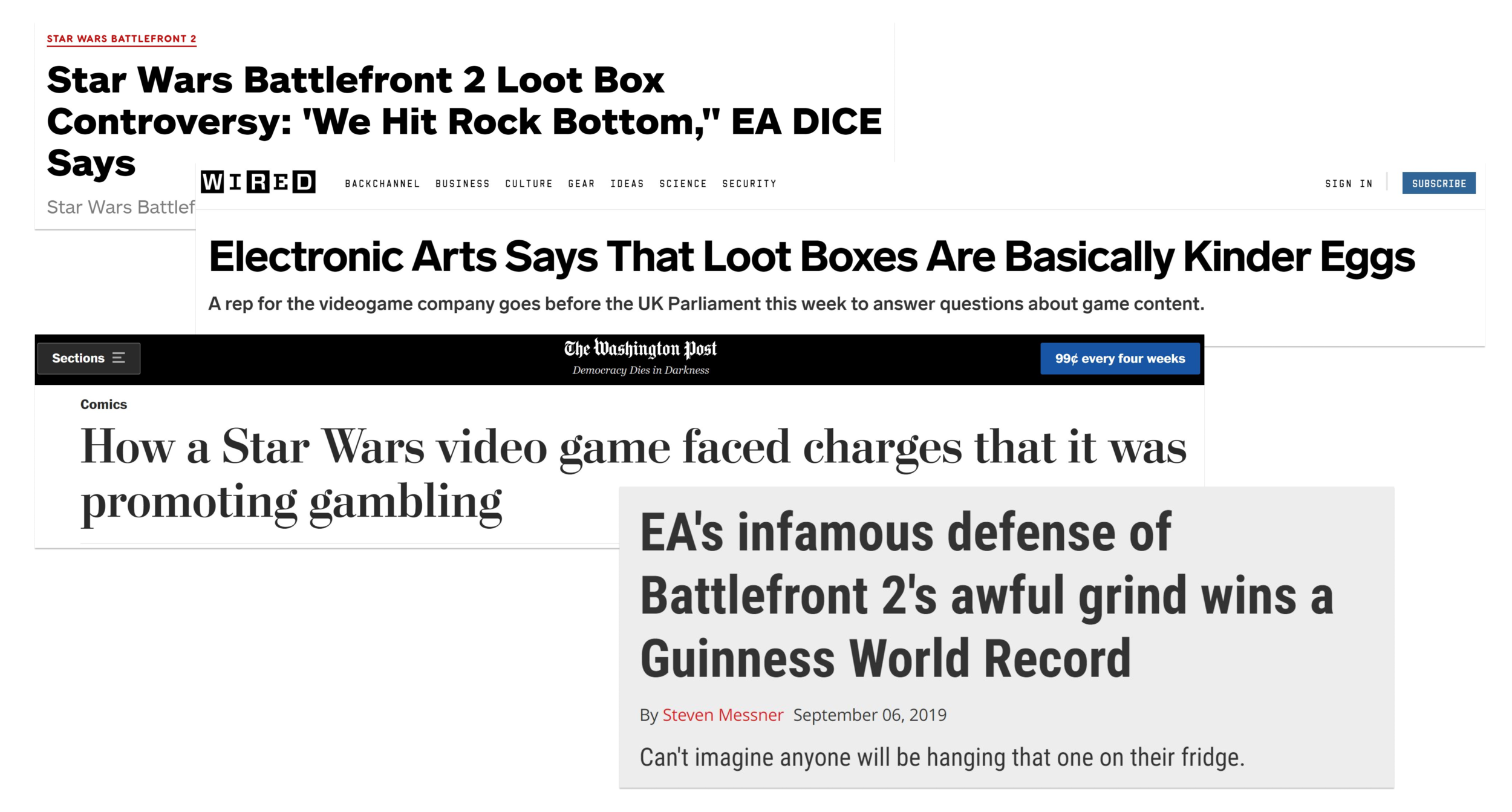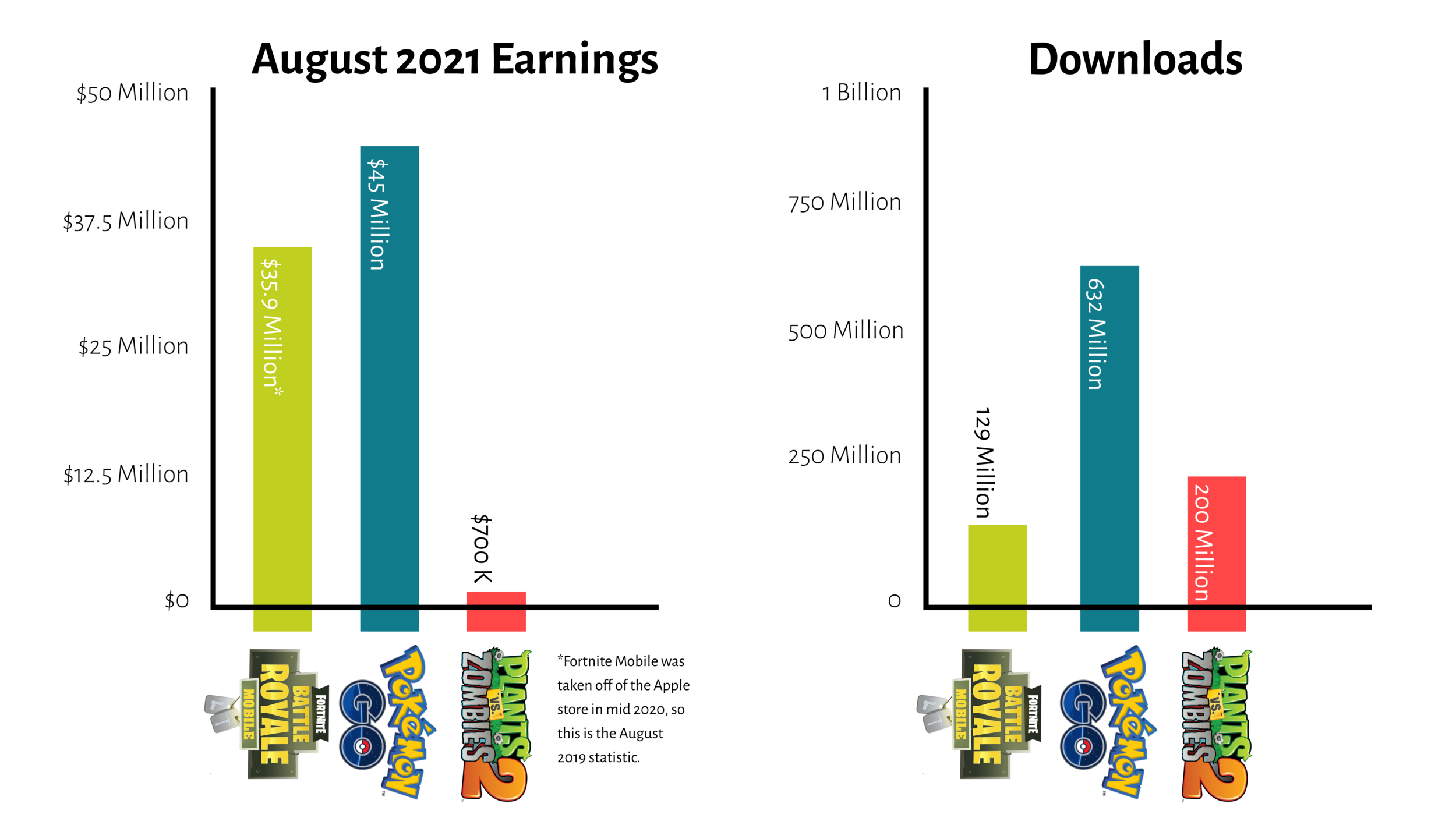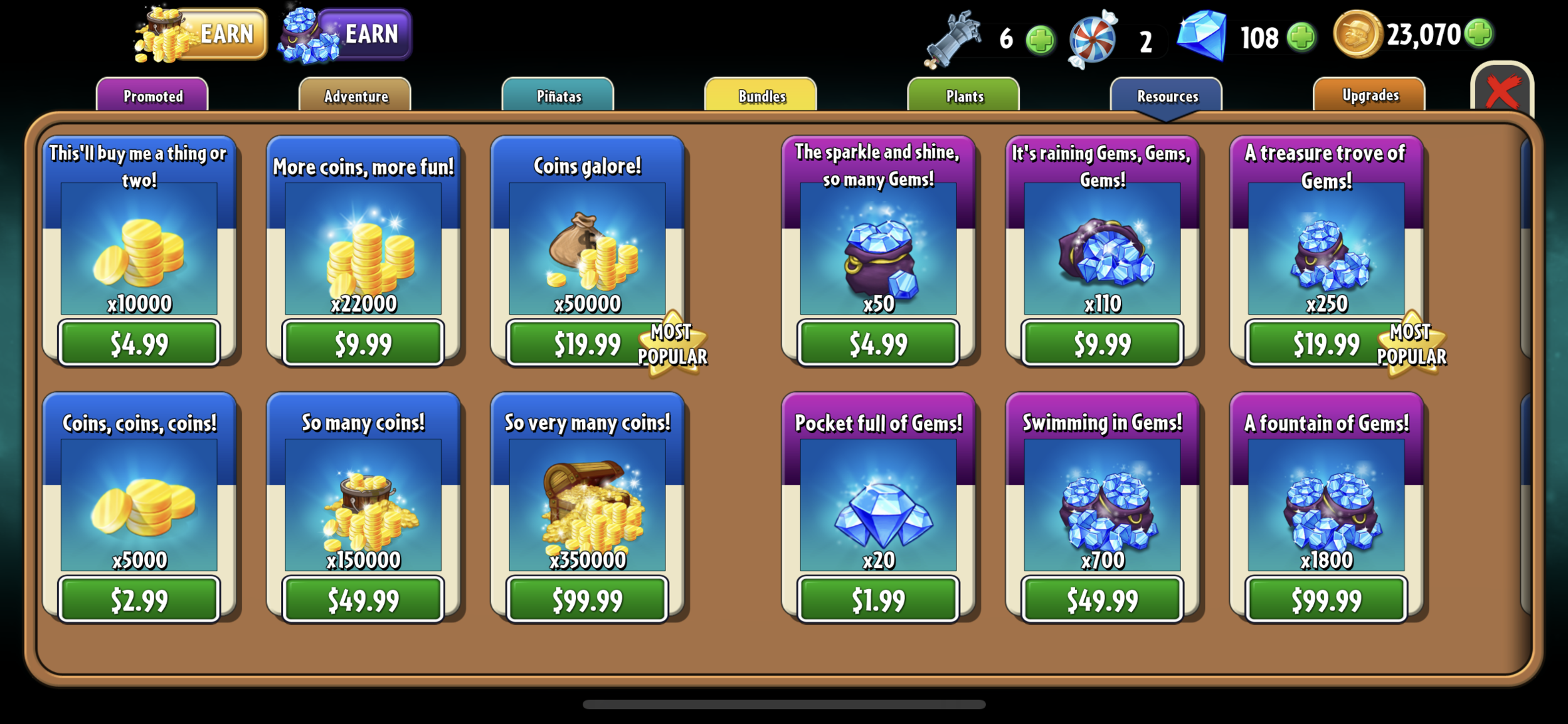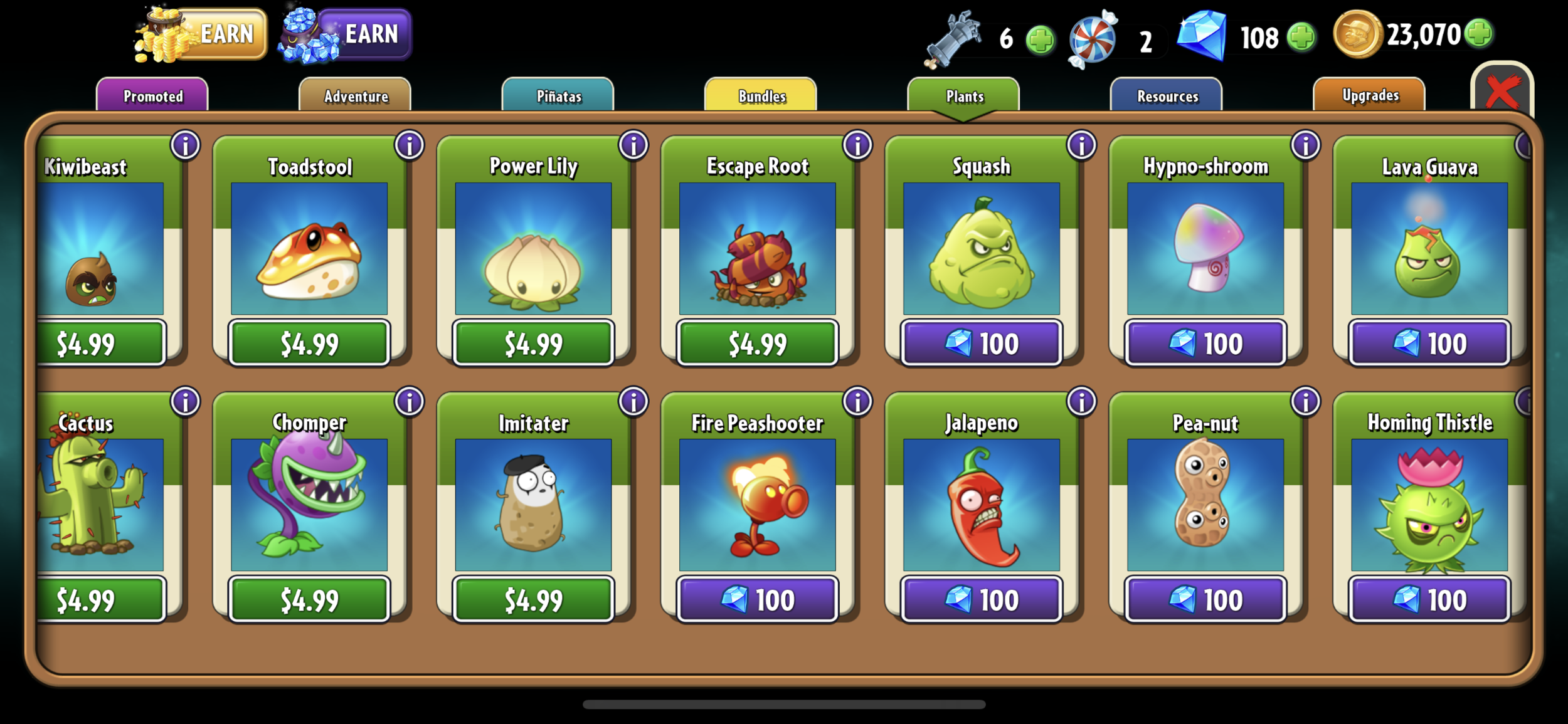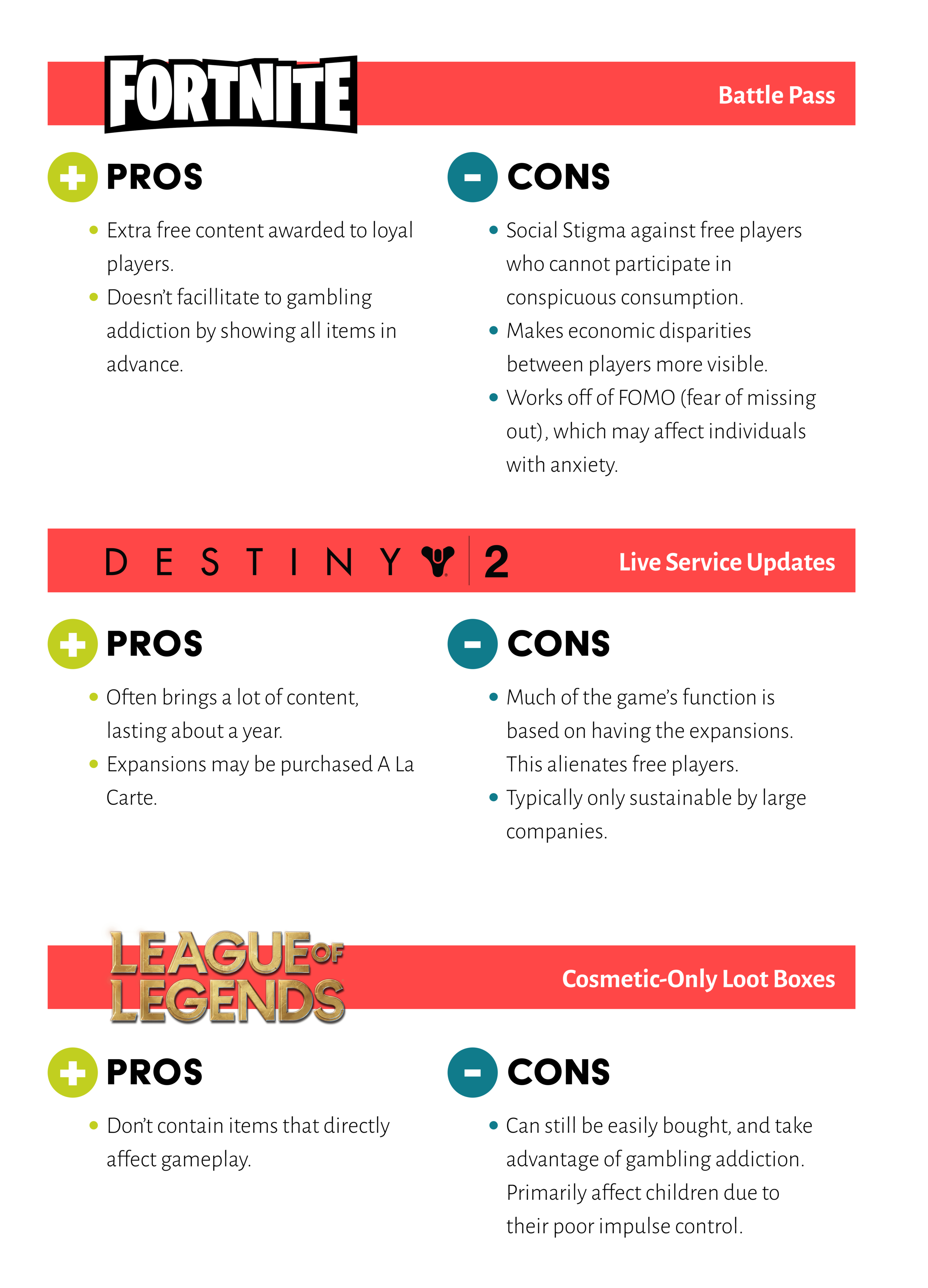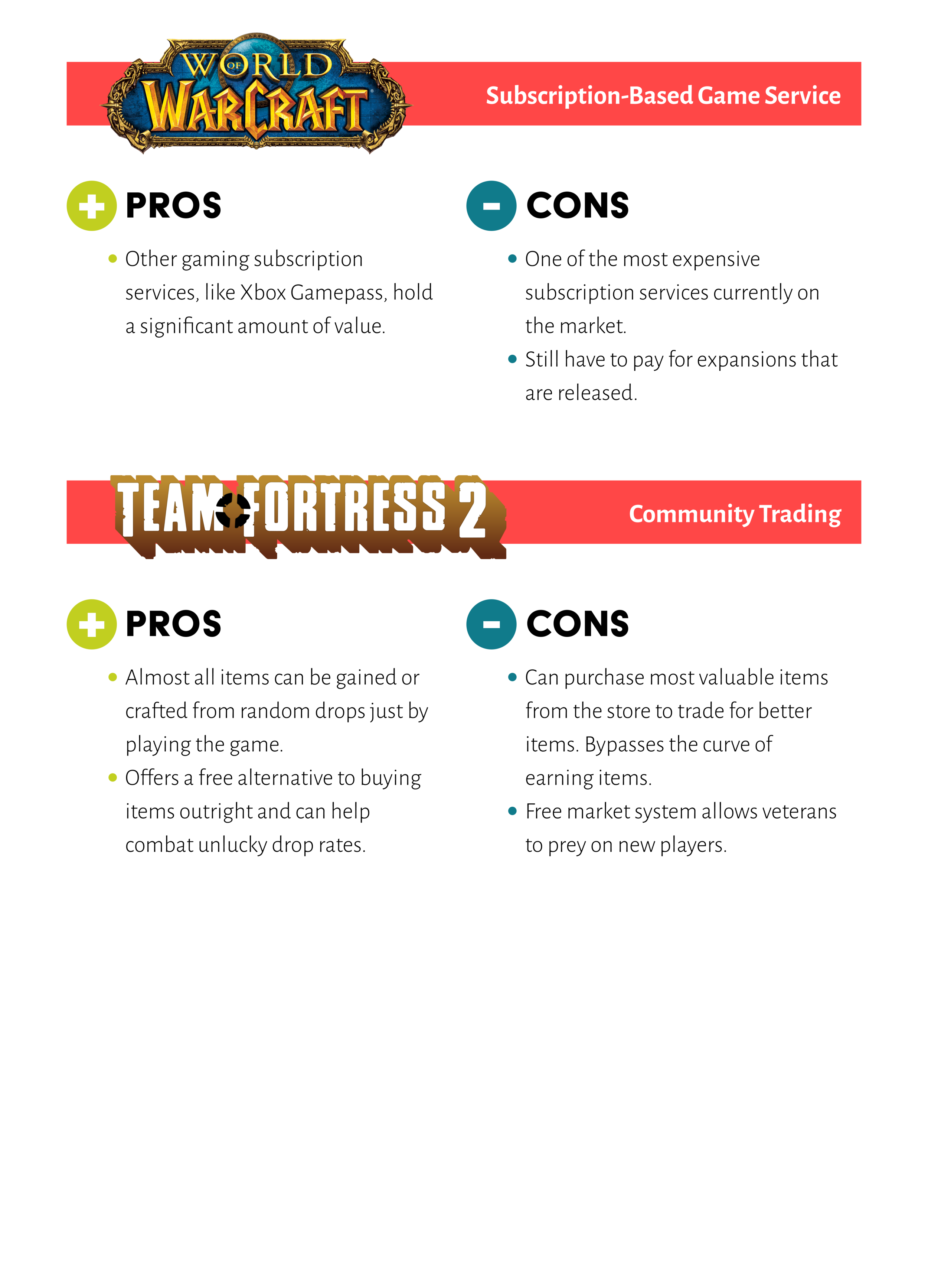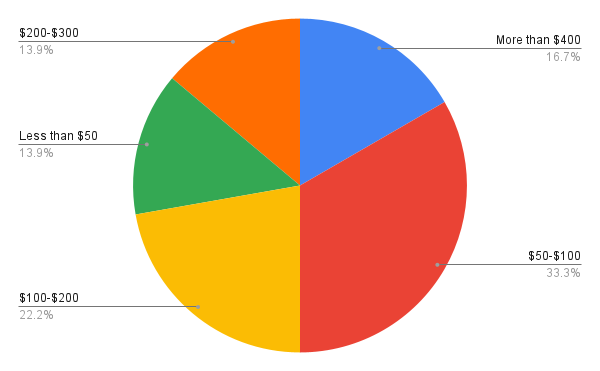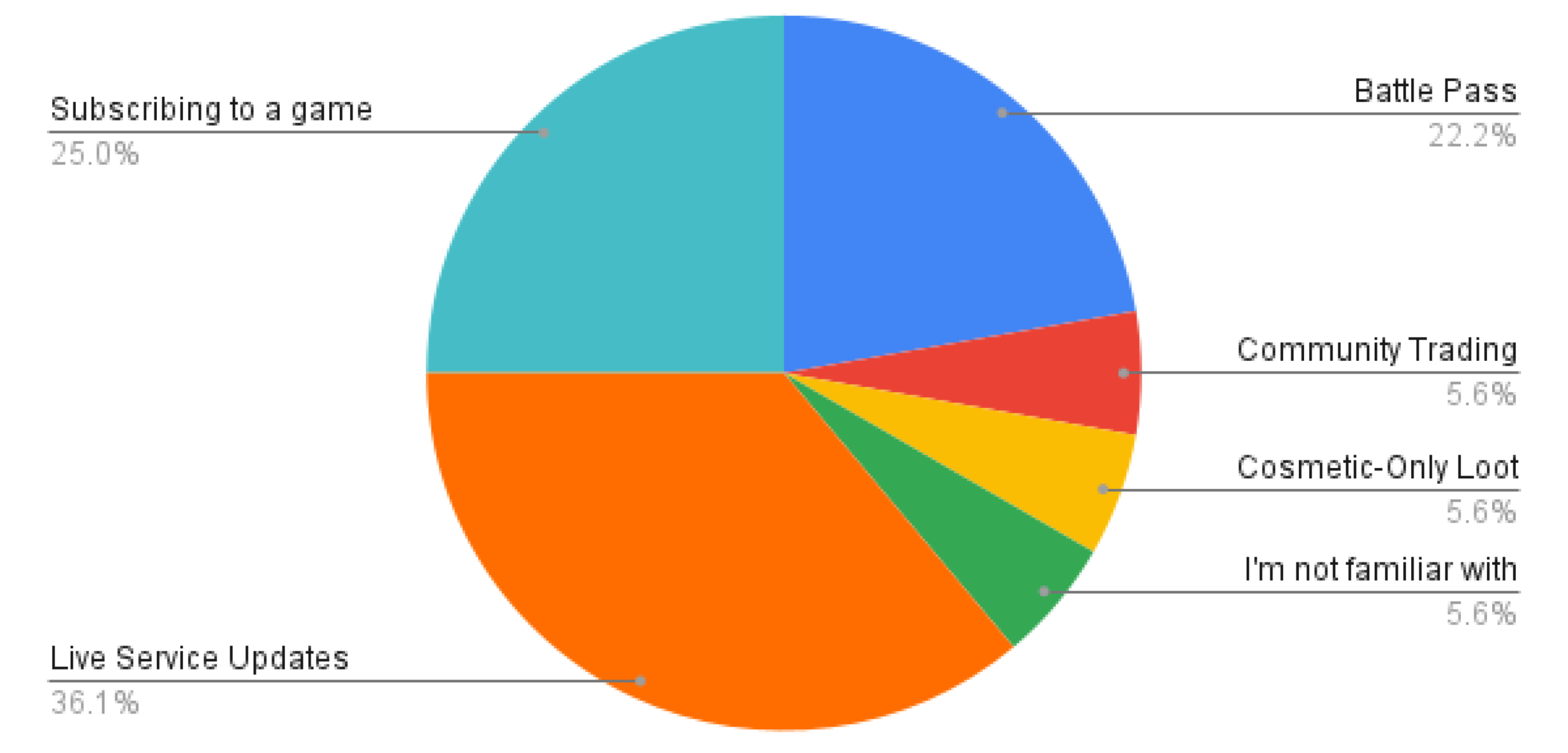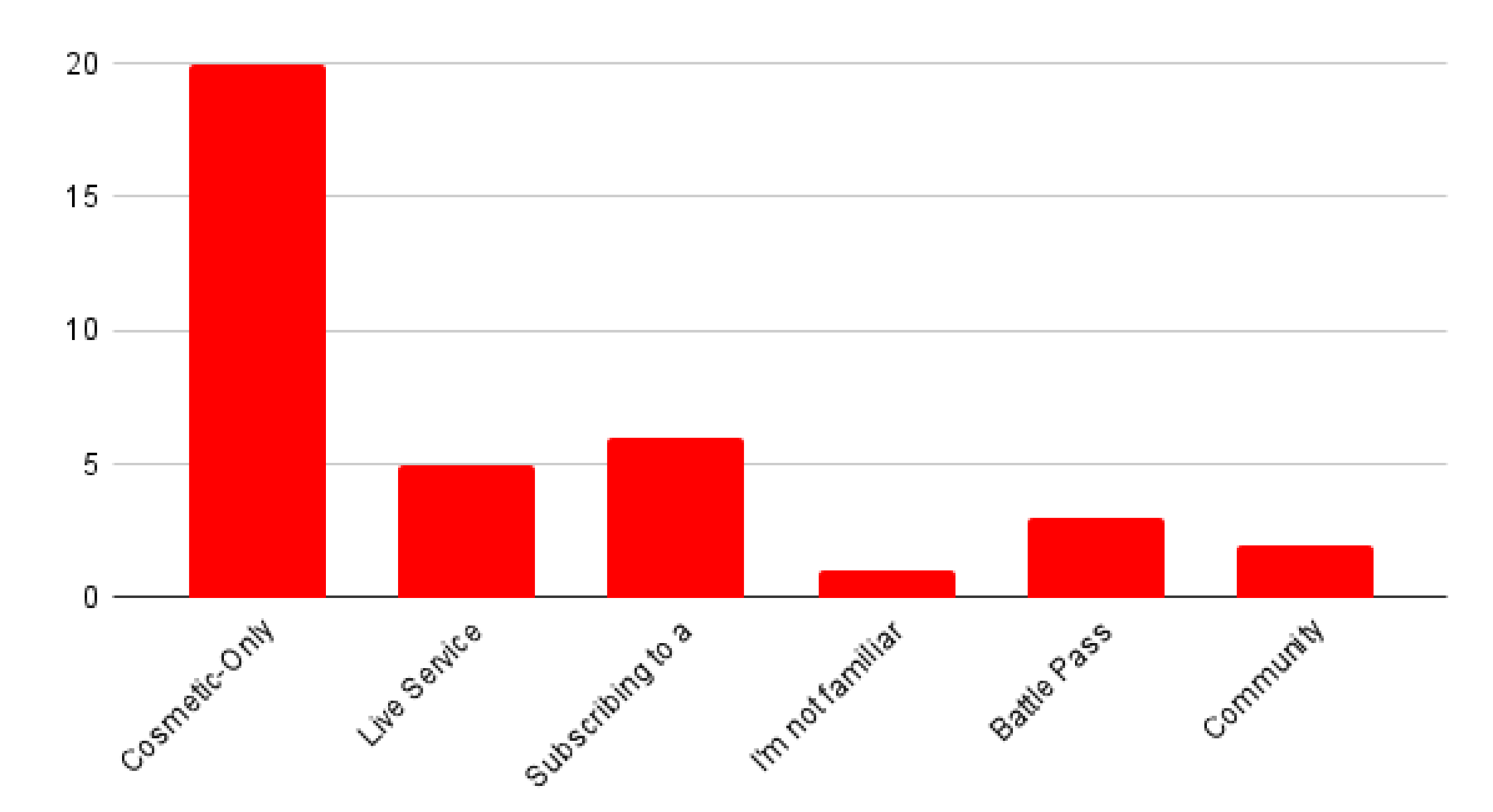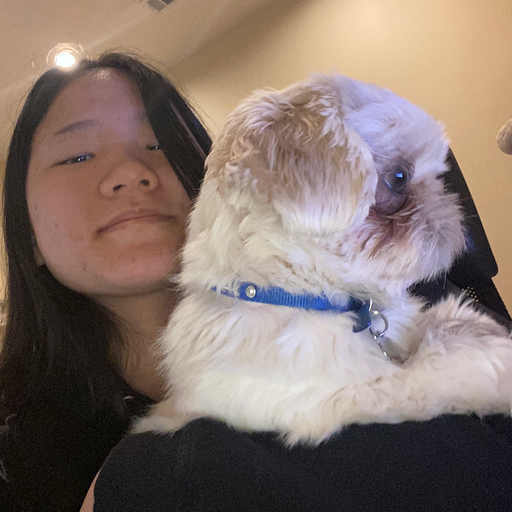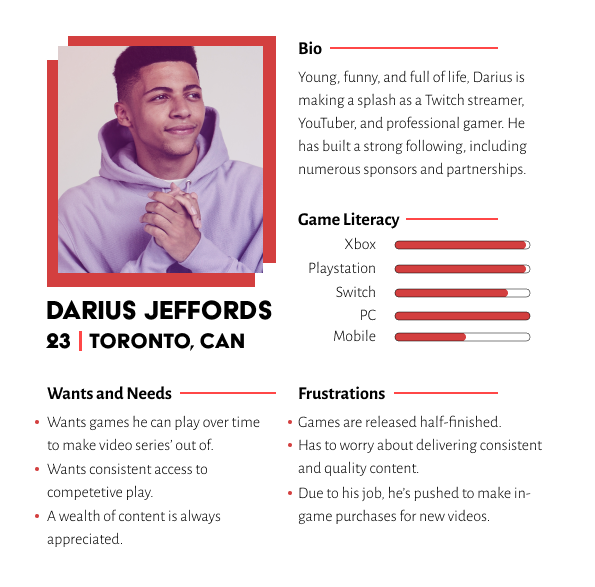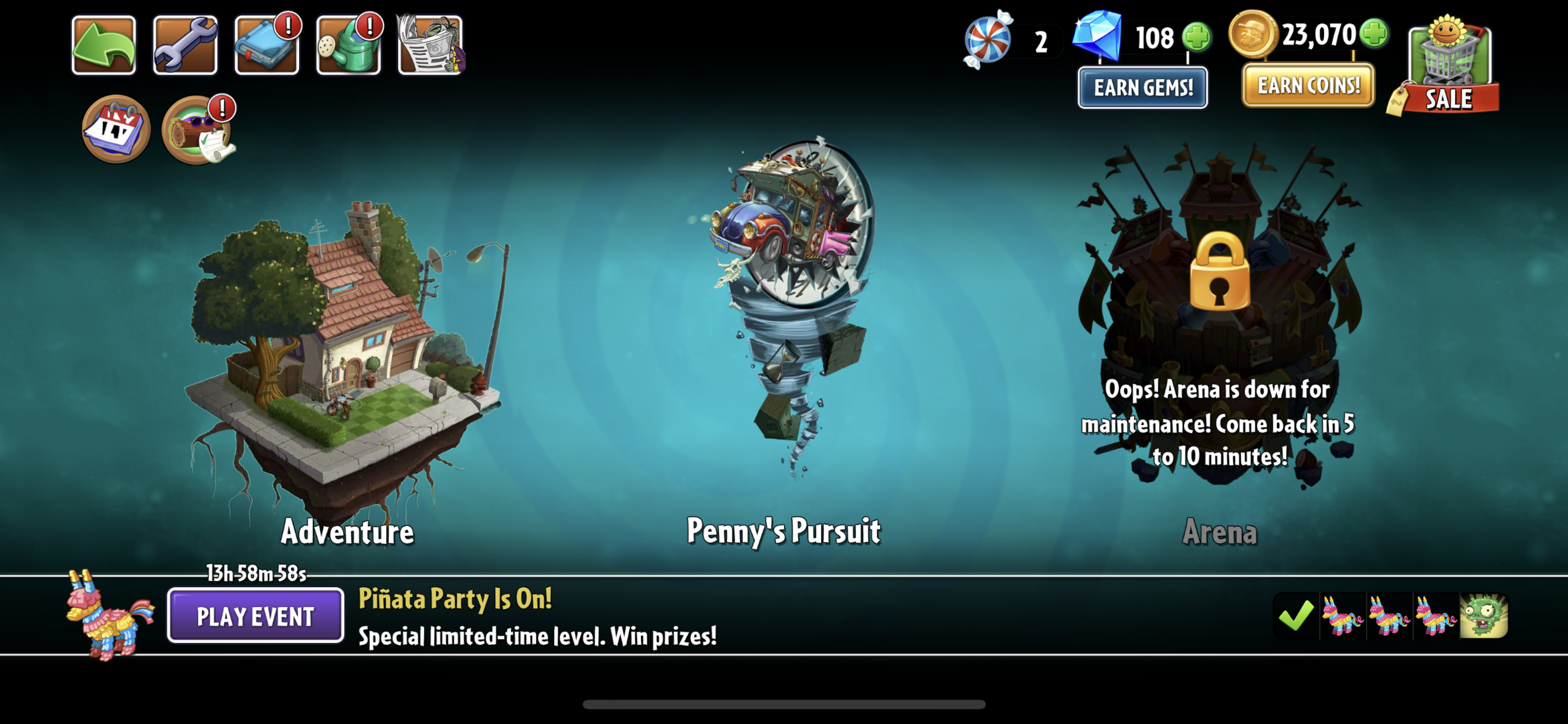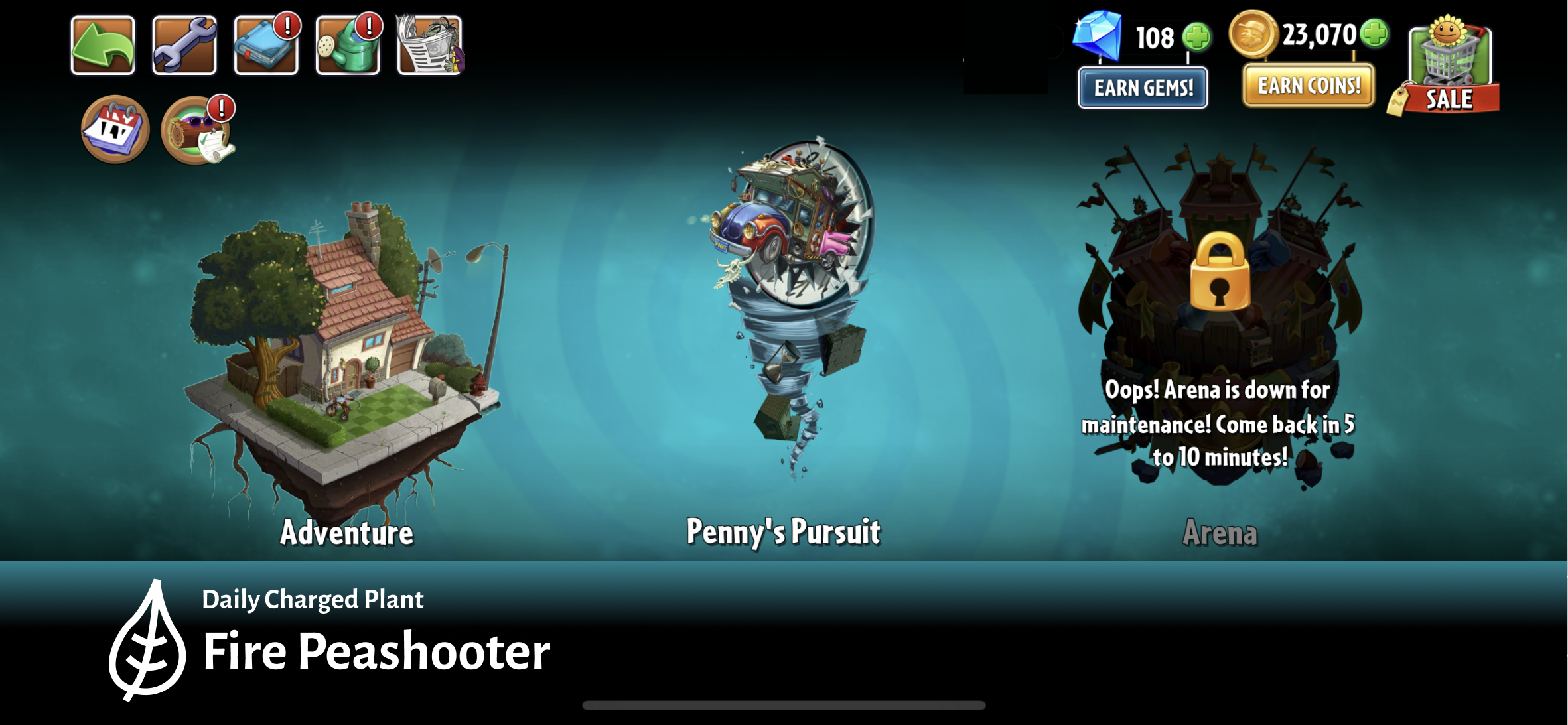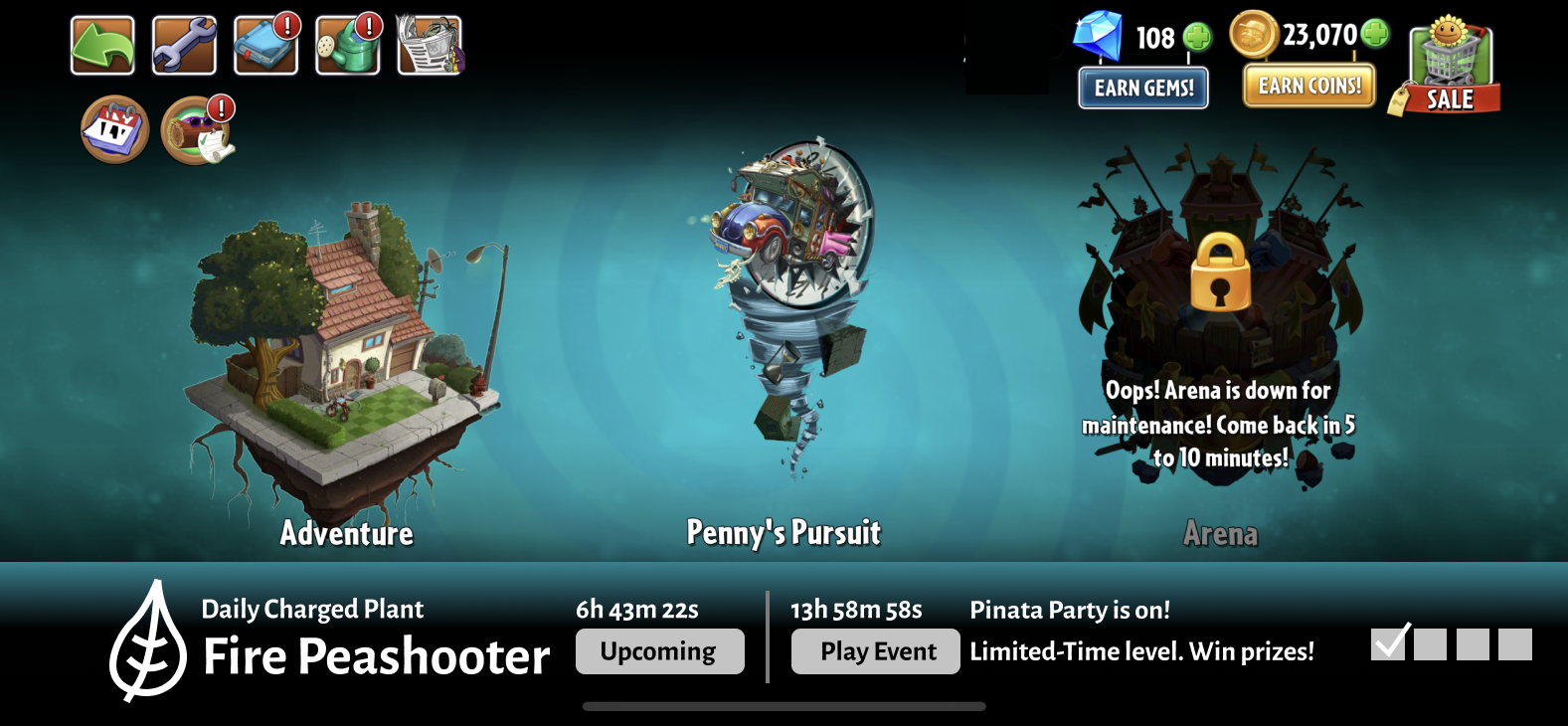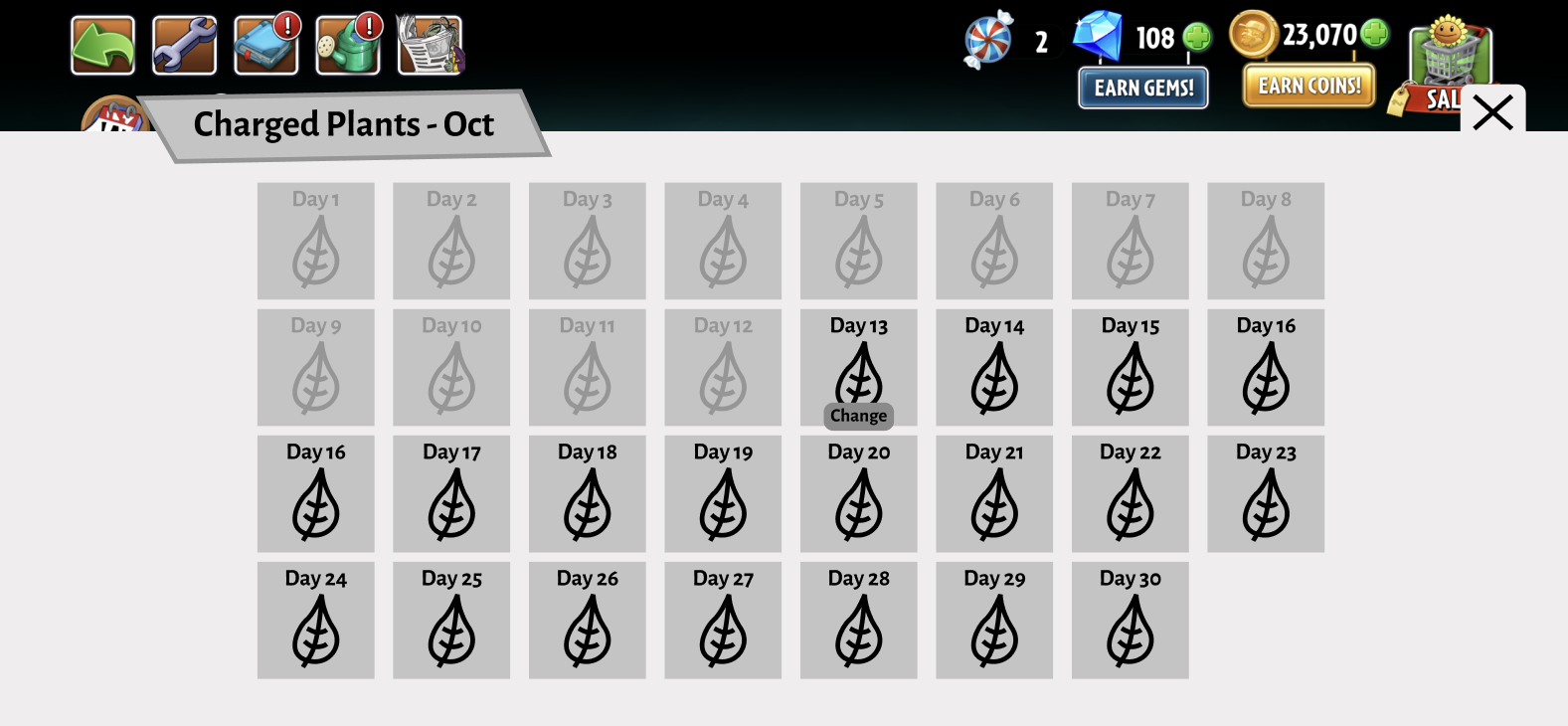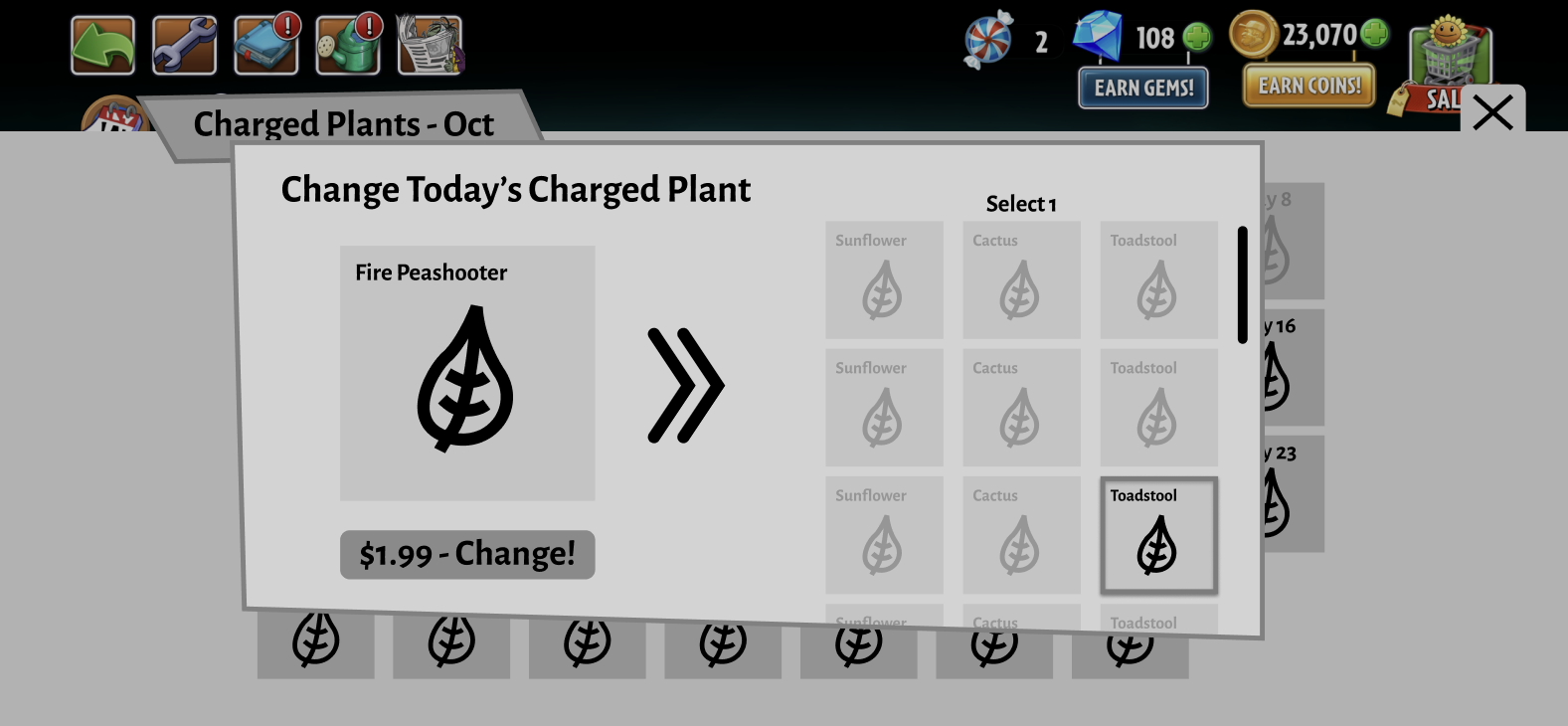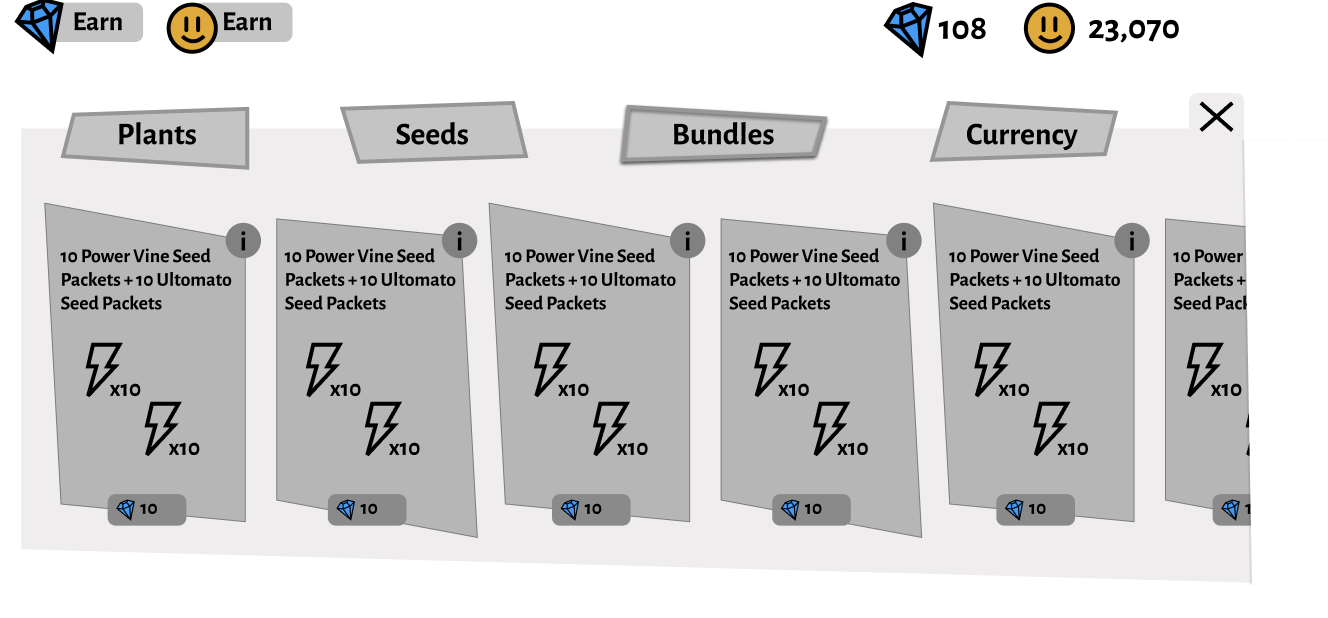Exploration // Pricing and Art Style
// An exploration of how ethical monetization systems in games can potentially boost revenue and public perception.Time to read: ~2.5 minutes
“At Electronic Arts, we exist to Inspire the World to Play. We create extraordinary new game experiences for our millions of players everywhere by bringing together talented people that combine creativity, innovation, and passion. We know that our strength lies in the diversity of our people.”
-EA Mission Statement
-
Electronic Arts (EA) is the 3rd largest gaming company in North America and the 7th largest in the world. As of 2020 it was operating on a revenue of $5.54 Billion.
-
Despite their Mission Statement, Electronic Arts is a repeat offender of practicing predatory methods of monetization like an overreliance on loot boxes and barring timely progression behind paywalls. Because of this, EA is generally regarded negatively by the gaming community, with some of their products, like the Battlefront 2 loot box system, becoming headline news and even landing EA in court.
-
Propose an Alternative monetary solution that is less predatory and intrusive, but still creates a comparable profit.
Target Market and Opportunities
The target market should encompass a large array of EA’s playerbase. Neither Casual, Competitive, nor Professional gamers are more or less important than the other two, so it would be best to try to include them all.
Plants vs. Zombies 2 is the perfect product on which to try to fix EA’s monetization issue, as it suffers from the same methods that have made EA infamous amongst gamers (lootboxes, intrusive shops, and locking timely progression behind a paywall). But it’s simplistic gameplay loop also appeals to the Casual, Competitive, and Professional archetypes mentioned above.
This is the perfect time for EA to begin raising its reputation with fans, given that one of its main competitors, Activision-Blizzard, is in hot water over numerous sexual assault allegations and the upcoming Holiday season could provide a huge boost to corporate optics.’
-circa November, 2021
Problem Statement
The current state of monetization in the gaming industry is focused above-all-else on creating a profit for the company, no matter the negative effects suffered by the player.
Existing products use dark UX tactics like Nagging, Obstruction, Interface Interference, and Random Mechanics to manipulate players into spending as much money as possible.
My product will redefine the overall experience of playing monetization-heavy games by changing the User Interface and Optimal Journey Map of the player.
I will focus on the game Plants vs. Zombies 2 by EA and Popcap because it has the same monetization issues as titles like Star Wars Battlefront 2 and FIFA, but hasn’t received as much attention.
Hypothesis Statement
I believe that creating a more user friendly system of monetization will both benefit players by allowing them to access more content without falling prey to Dark UX techniques, and corporate shareholders by making the company more reputable in the eyes of fans, who then will want to spend more money to support their favorite games. I believe I can achieve this with a new monetization model that removes excess currencies and random chance from the user experience.
Preliminary Research
This comparison is not perfect. Pokemon and Fortnite are larger franchises than Plants vs Zombies, but the discrepancies are still shocking- especially when considering that PvZ2 came out 3 years before Pokemon Go (see downloads) and EA is a higher earning company than Epic Games (see earnings). Simply put, Pokemon Go and Fortnite have less intrusive, easier to understand, and more creative methods of monetization than Plants vs Zombies 2. And these systems keep players coming back.
Current in-game store Overview
I took a brief overview of the current store to start getting an idea of what systems are in place that I would want to test later and questions to ask about the experiences of players with those systems.
Some of the most notable issues //
Plurality of currency options.
Potentially questionable pricing.
Overabundance of unclear and unnecessary categories.
Some text is too small, and compact kerning affects legibility.
Loot Boxes facilitate gambling addictions.
Some UI elements are too small for average fingers.
Reliance on Fear of Missing Out (FOMO). I.E. time-limited content.
Competitive Analysis
In order to get ideas on what kind of monetization system would work for Plants vs Zombies 2, I began by looking at monetization systems in other successful gaming titles.
Survey Results
Because the Over of the In-Game Store and the Competitive Analysis were only my personal assessment of systems (with some light research), I ran a survey to understand how the pros and cons of these systems actually weigh out. I received 37 responses.
Question // What is the maximum amount of currencies you’re comfortable seeing in a game?
Analysis // Users are most comfortable seeing between 1 and 2 in-game currencies.
Q: What kind of benefits are you looking for when you spend money in a game?
Analysis // A tied majority of users paid money to either Look Cool or Gain an Advantage.
Question // What is the most amount of money you’ve spent on a single game?
Analysis // The most people spent in a single game is between $50-$100.
Question // Which system are you MOST likely to spend money on?
Analysis // Players are most likely to spend money on Live Service Updates or use a Subscription based platform.
Question // What is the LEAST ethical form of Monetization?
Analysis // Cosmetic-Only Loot Boxes are far and away the least ethical form of Monetization, according to users.
Question // What is the MOST ethical form of Monetization?
Analysis // Live Service systems and Cosmetic-Only Loot Boxes are the most ethical forms of Monetization.
Anomaly ^^
Somehow, Cosmetic-Only Loot Boxes were voted to be both the most ethical and the least ethical form of monetization. Given its commanding lead for being the least ethical, I’m not inclined to believe that this statistical anomaly can be explained by different people simply having different opinions. Although this is possible, the difference seems too drastic.
Interviews
I conducted a set of interviews in hopes that they would shine some light on the Cosmetic Loot Box anomaly.
Douglas Parks //
-
“Ah c’mon man I hate that stuff. Let’s just have the full game.”
-
“Smash Bros. I’ll buy the DLC characters because they’re typically more powerful.”
-
“The first things need real money and it keeps asking me to watch ads. Even the free stuff is to get you wanting more.”
Lee Ryder //
-
“They’re okay I guess. Not nearly as bad as the ones that affect gameplay.”
-
“Probably Clash of Clans. Gain gems> gain stuff> push yourself forward.”
-
“Why do I have to pay to unlock most of the plants?” (Specifically mentions the ‘Chomper’ which was an iconic plant from the first game)
Tess Bond-Keith //
-
“I’ll buy them if they look cool.”
-
“Call of Duty: Modern Warfare. I bought the ‘Precision Edition’ because it came with more stuff.”
-
“I’m a bit of a gamer perfectionist, so obviously I want to get them all. They know that, and they’re making me pay for them.”
Analysis
Due to the overwhelming negativity towards Cosmetic-Only Loot Boxes in both the ‘Least Ethical Monetization’ survey and all 3 interview participants, I will move forward as if they are not a viable possibility for my alternative monetization method.
Personas
Primary Takeaway
Remove or circumvent the complexity that comes with new content drops over time.
Primary Takeaway
Remove factors that trigger gambling addiction.
Secondary Takeaway
Remove factors contributing to FOMO.
Primary Takeaway
Deliver a consistent stream of quality content.
Secondary Takeaway
Money is not necessarily a problem for a professional user.
Ideation
When thinking about this design, I narrowed it down to 2 different facets that needed to be addressed…
1 // New Monetization System
My testing showed what kinds of monetization systems people are most comfortable with. Now I need to ideate to create a system using elements of those systems to create an experience that is financially lucrative, ethical, repeatable, and uniquely Plants vs. Zombies.
2 // Shop Redesign
In order to account for the wants of my users and the removal of numerous features like Piñatas (the PvZ2 equivalent of loot boxes) and excess currencies, I’ll need to overhaul the in-game store in both aesthetic and content.
New Monetization System
I ended up developing a ‘Daily Charged Plant’ system. 1 Plant every day is ‘charged’ and will reward more upgrade points when played. This provides daily drips of content. You can look ahead to see which plants are charged each day during that month. This removes random chance. There are a limited number of plants, and plants will invariably be repeated. This removes FOMO. And you can pay a small fee to change the charged plant for the day. This ensures that there is still a stream of revenue while maintaining player choice. But the cost is so low that hundreds of thousands more people will use the system, which contributes to EA and Popcap retaining a comparable profit.
Monetization Presentation
To incorporate the new monetization system, I also needed to design how it would appear in the app. The most effective placement proved to be the bottom of the home screen, making use of the large amounts of negative space left by the Events banner.
Button Variations
My overhaul of the button appearance had 2 purposes. First and most obviously, I wanted to address the usability issues that came with the overly small UI elements I had identified in my initial overview. But during my research, another issue came up that I hadn’t expected: Plants vs Zombies 2 doesn’t abide by the official Style Guide of the Plants vs Zombies property.
This Style Guide puts a much greater emphasis on jagged and asymmetrical geometry for UI elements. But while I wanted to implement this I also wanted to maintain some pattern, given that this is a mobile application with a strong horizontal scroll, and so these buttons would be seen repeatedly. This became a question of how I could use these elements to embody the game’s “quirky” nature without sacrificing usability.
Wireframes
Because the Charged Plant system works on a day-by-day basis, I made the UI similar to the reward calendars that PvZ2 already uses. This provided continuity and recognizability in testing. I opted for squares on the calendar over the more bombastic geometric forms because the form is too regimented and the size of each box is too small for any asymmetrical shape to be used without negatively impacting legibility.
The first look at the new shop, now with fewer and more concise categories and cut down to two currencies from five. This change made it easier to new players to jump in. The visual changes are also working better than the current model, with larger buttons and kerning proving easier to interact with and read respectively.
High Fidelity
The color and imagery really made the new UI pop! A more fitting UI and the removal of random chance mechanics has made PvZ2 more fun to look at and play.
A further fleshed-out Charged Plant system, including the ‘change’ selection process fits perfectly into the PvZ2 architecture. Adjusted pricing is just low enough to encourage repeat use.
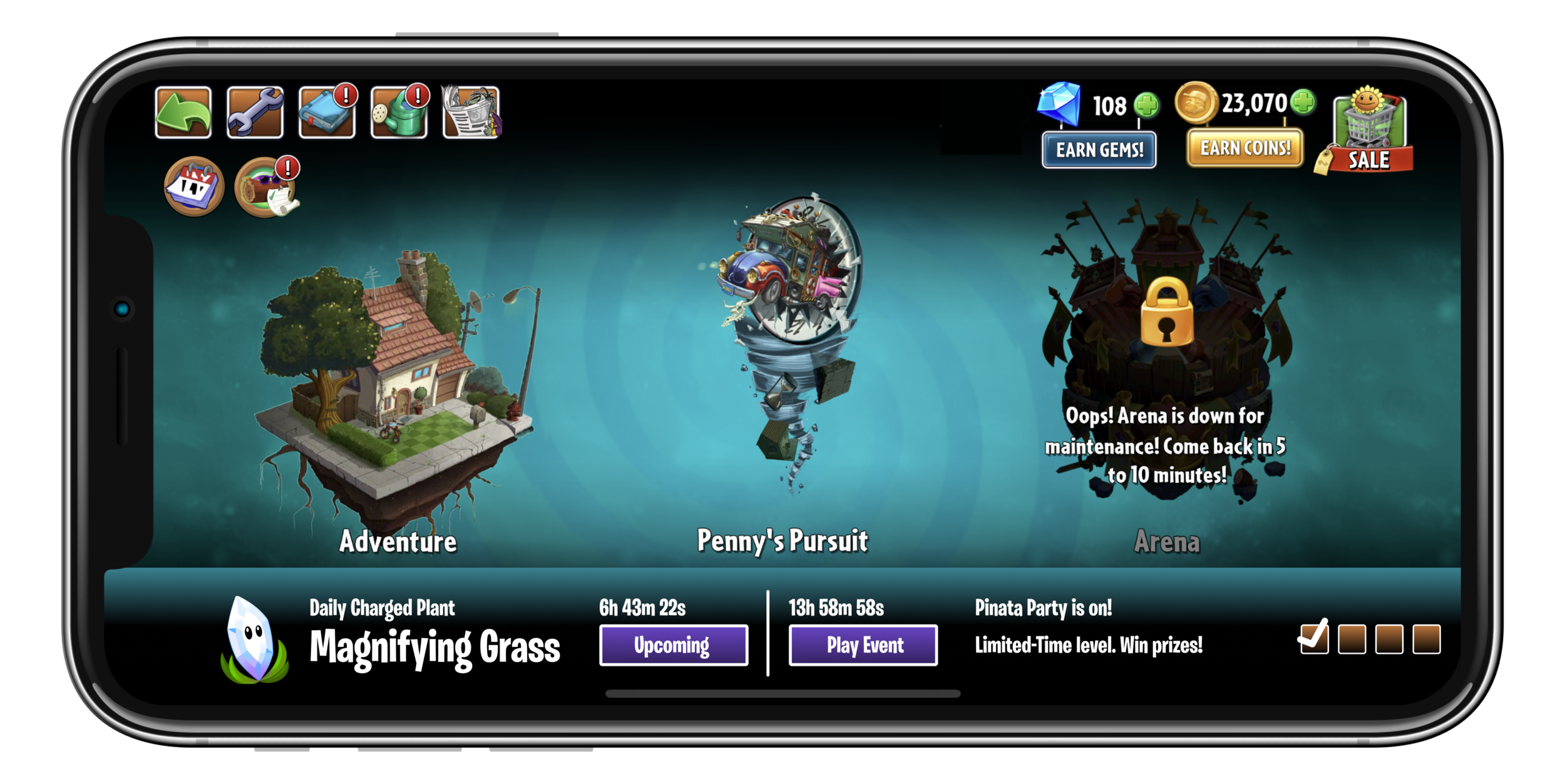
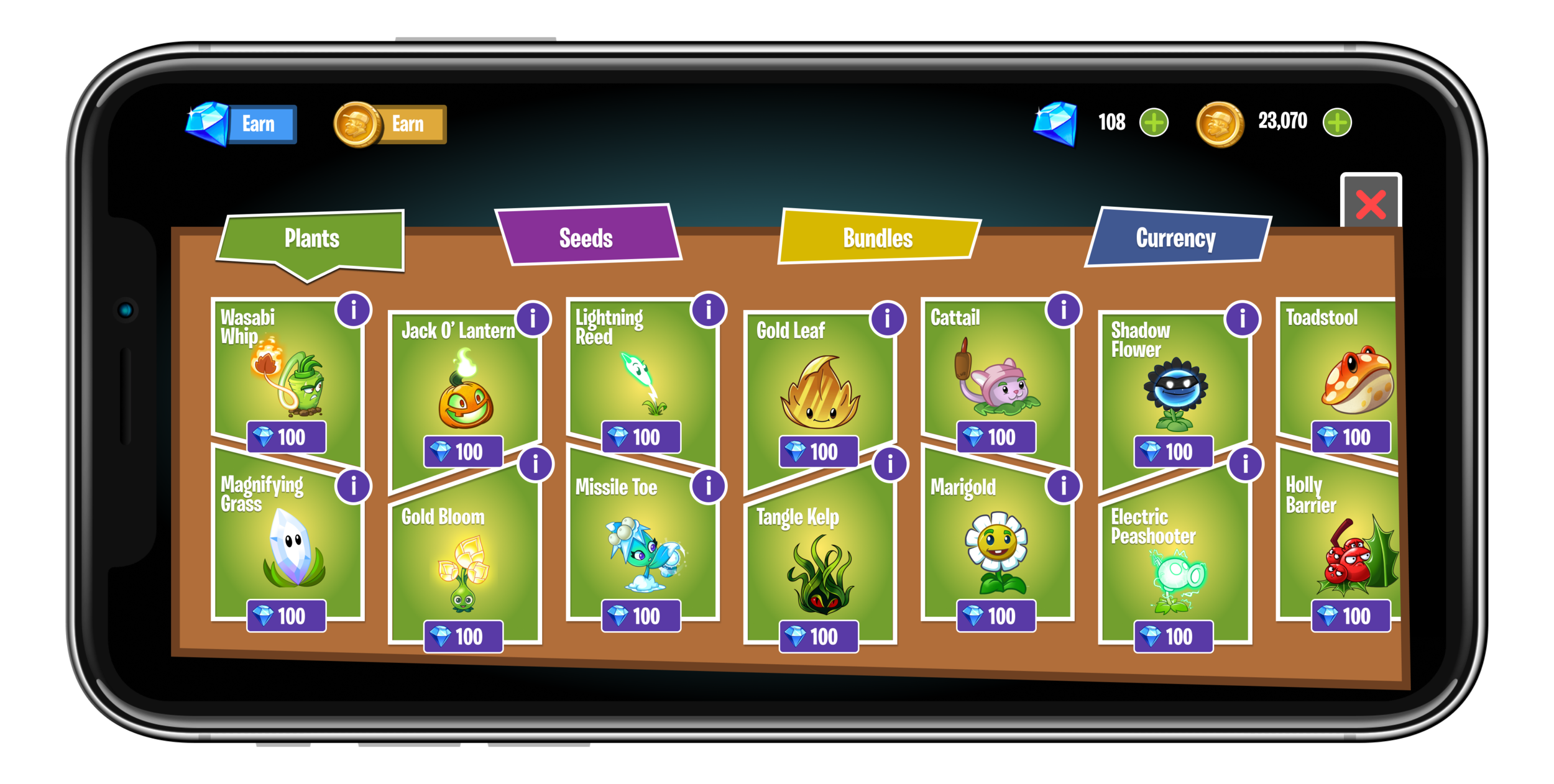
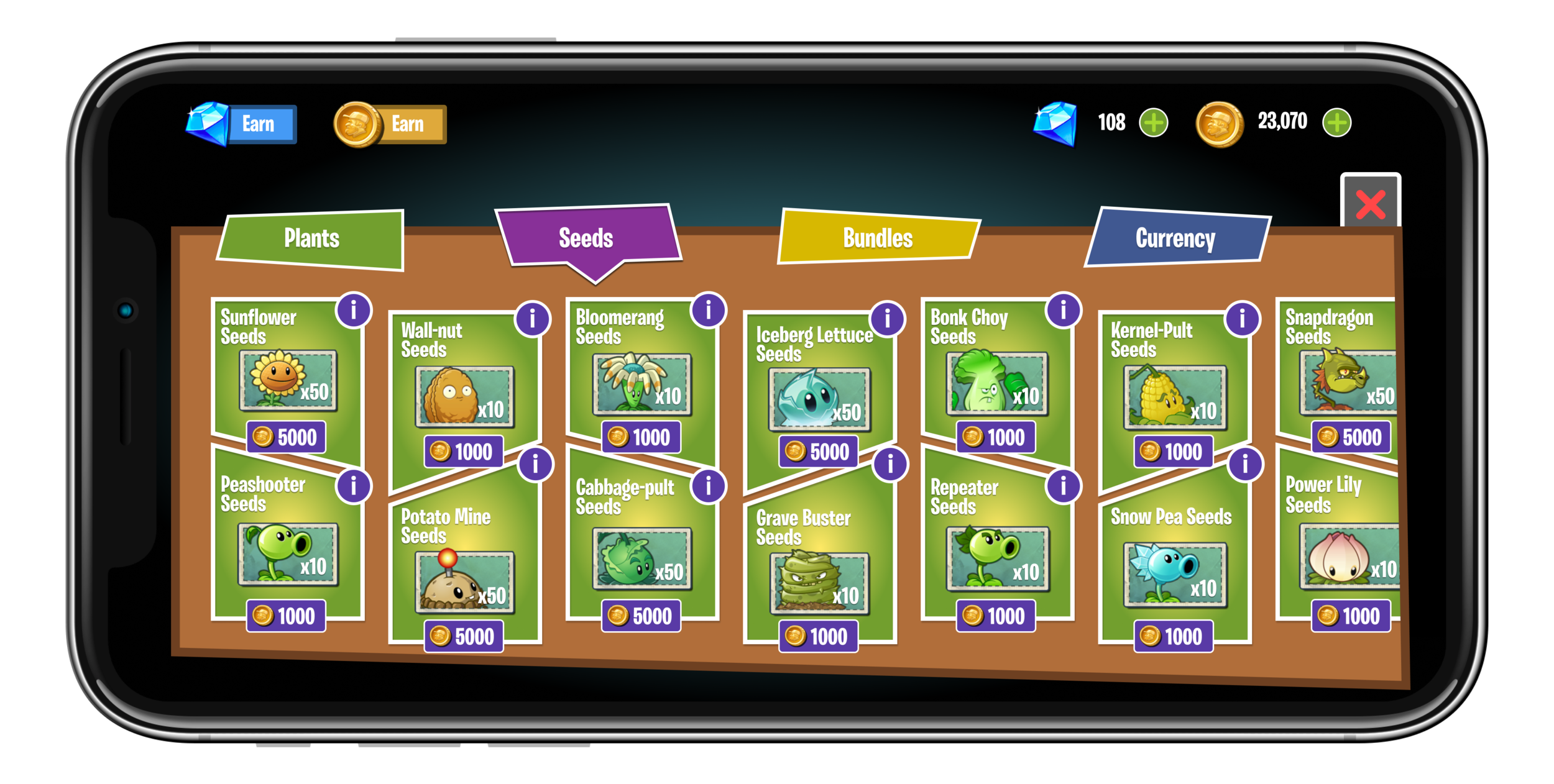
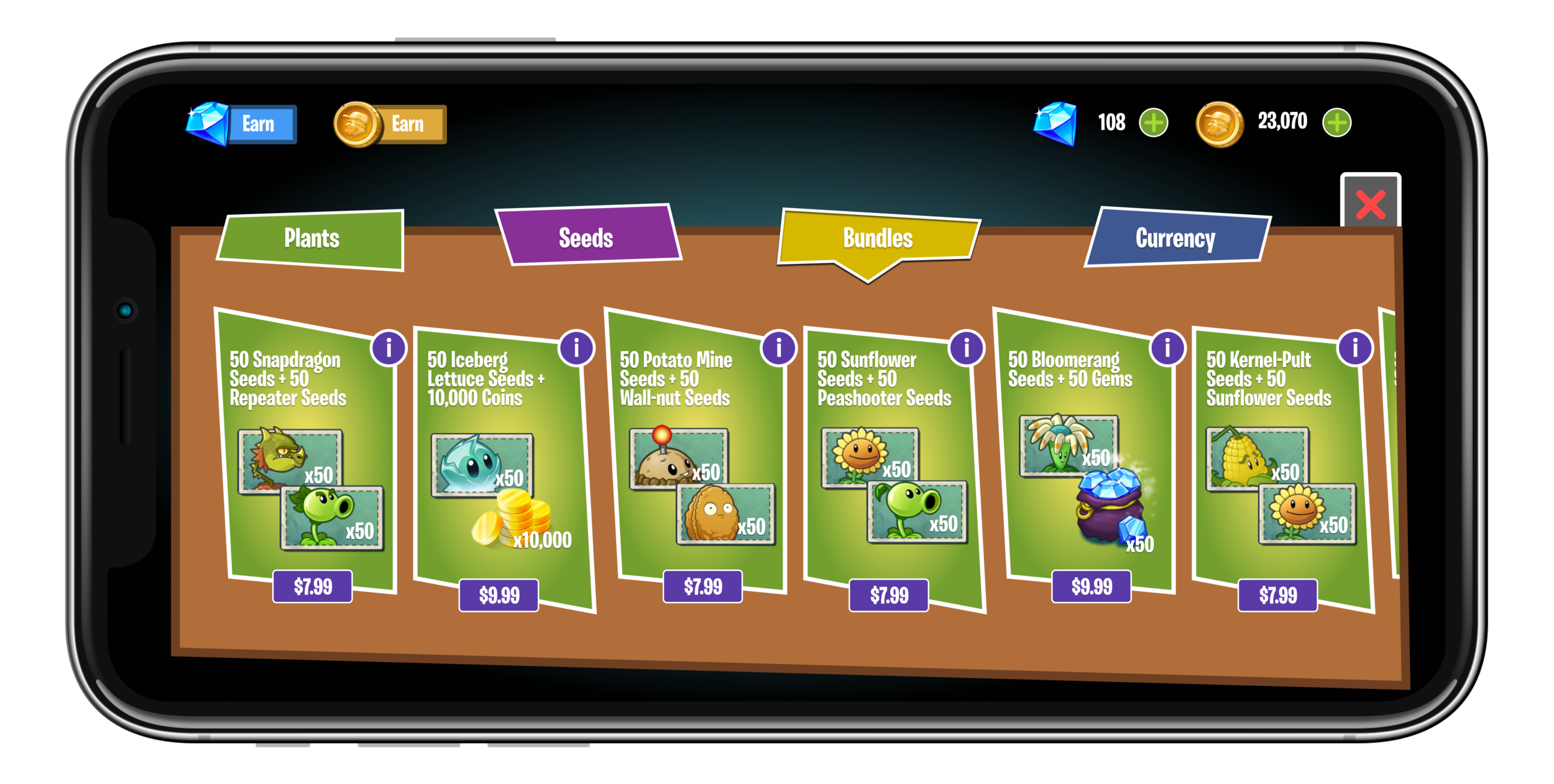
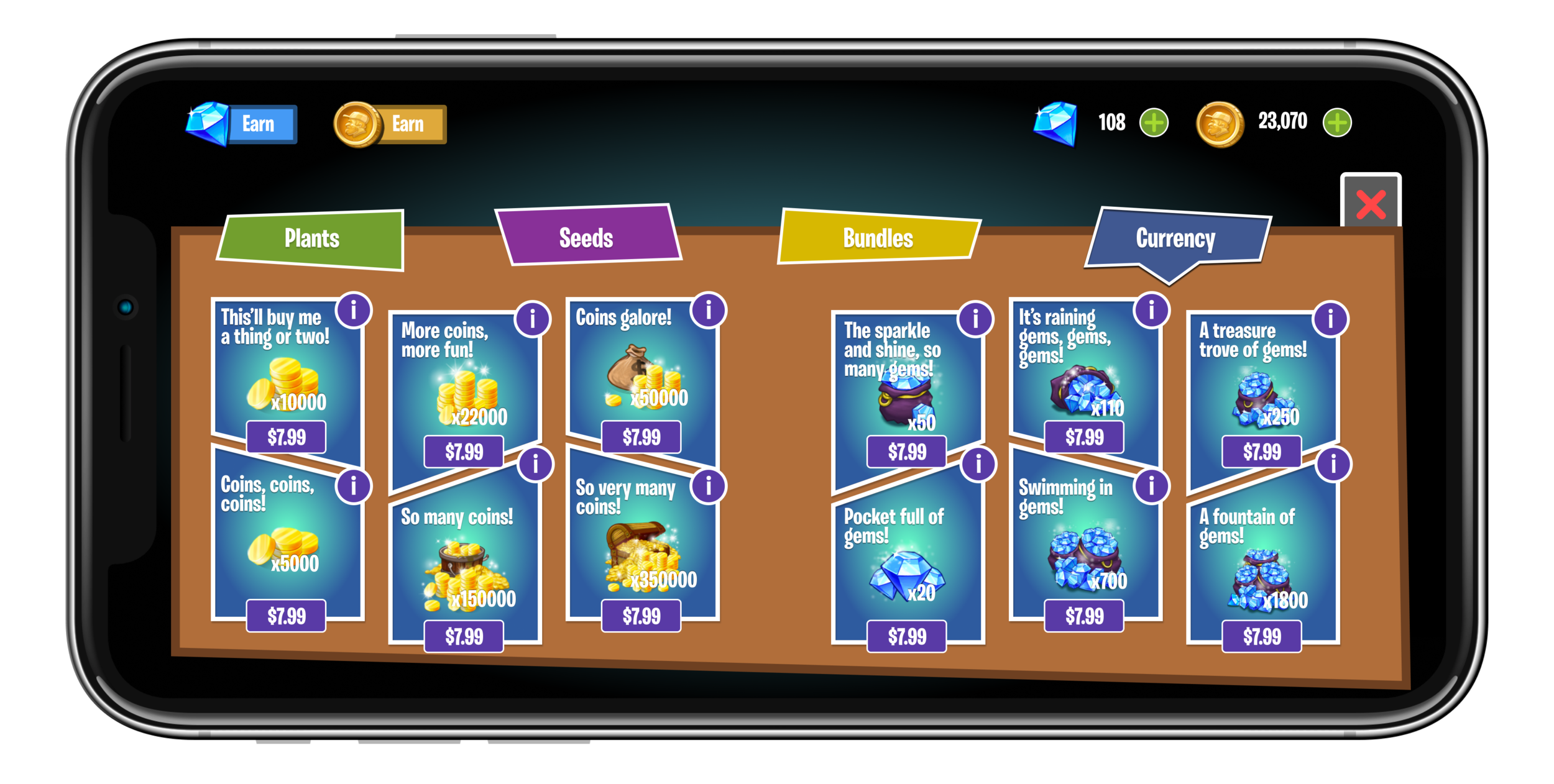
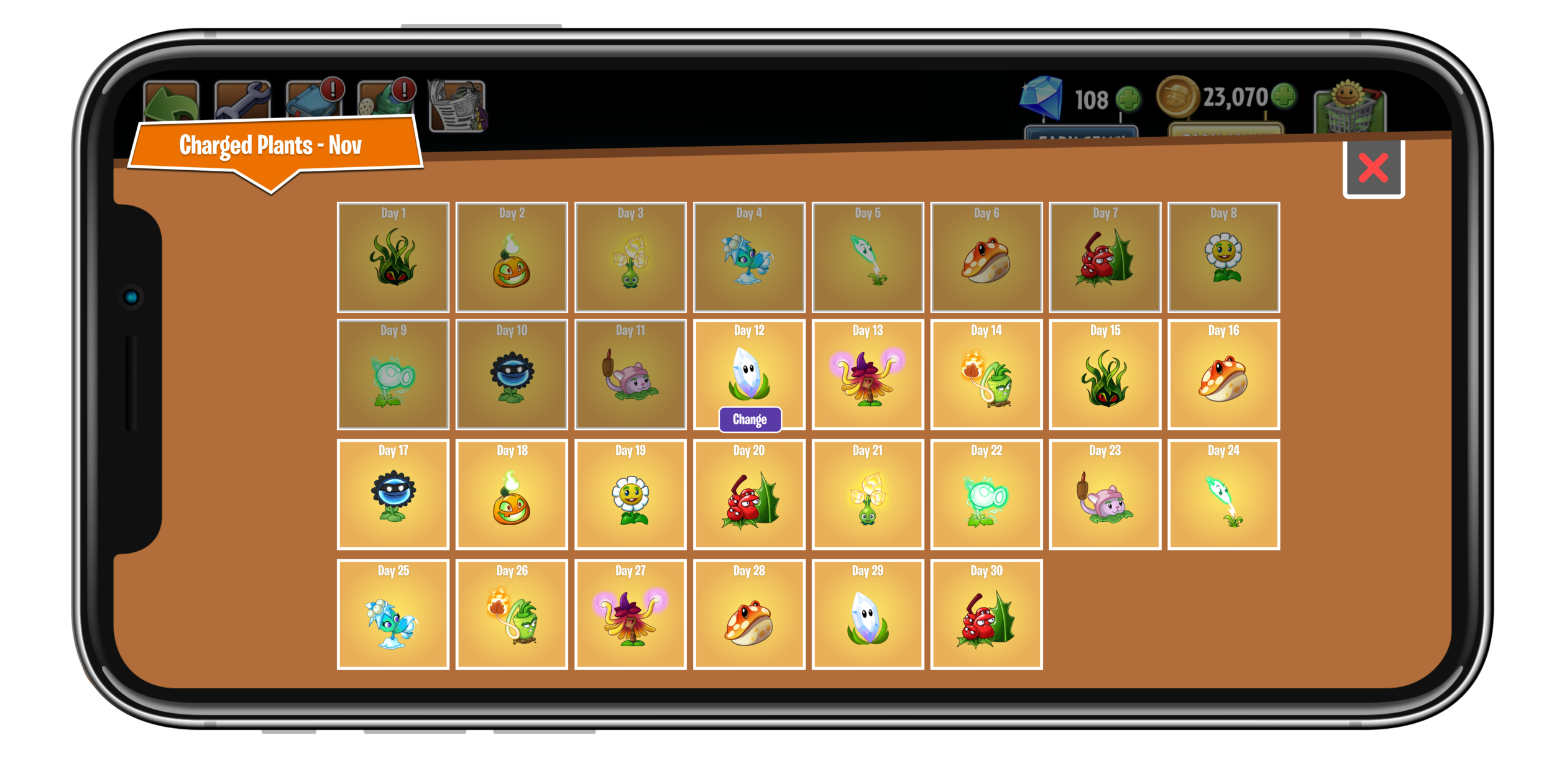
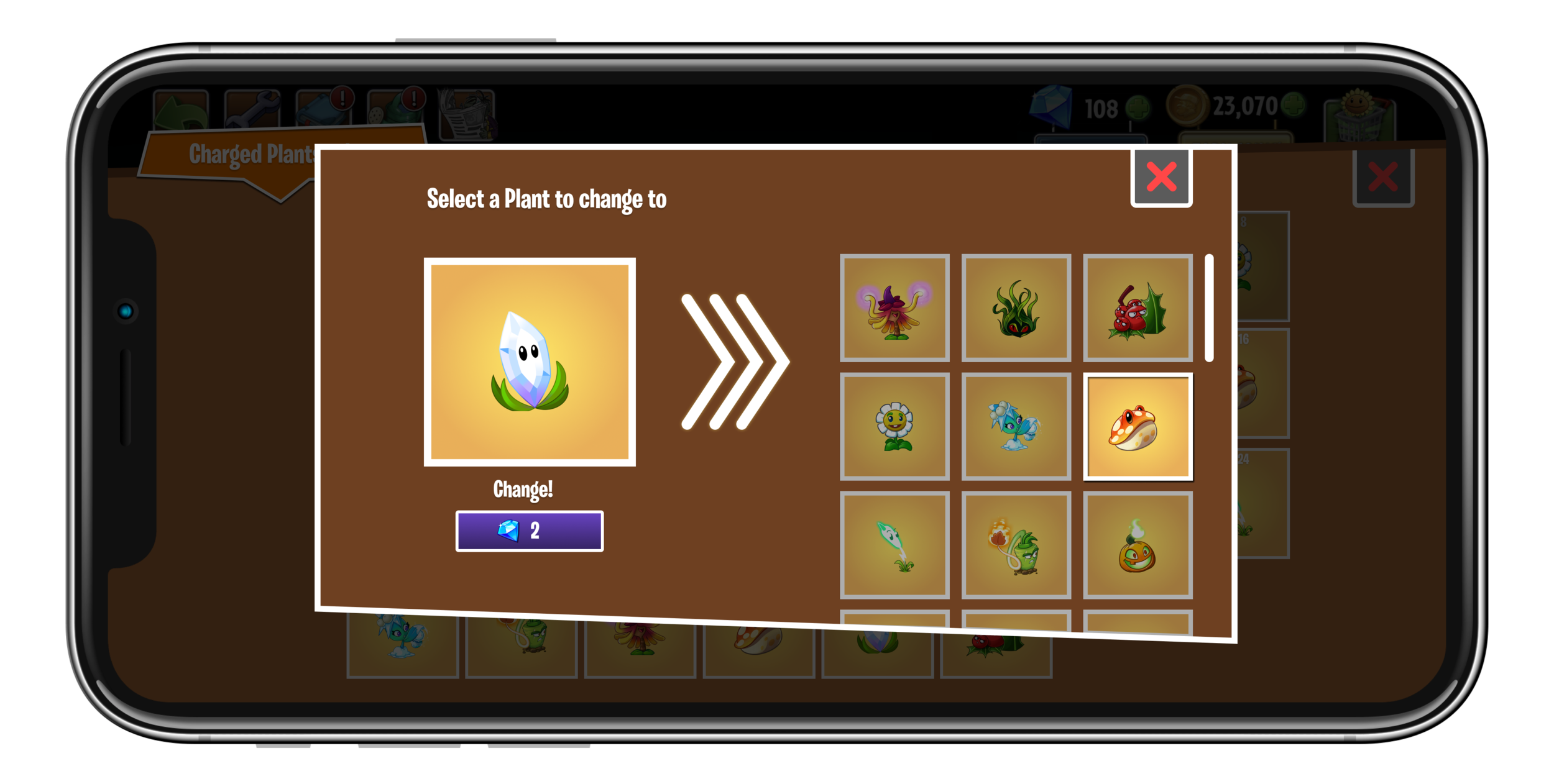
Future Considerations
Systems like the one I’ve put forth here have the potential to make the gaming world into a more empathetic and inclusive space, but how do we get there? The keyword is ‘potential’. Due to time and physical constraints, I wasn’t able to do as much testing as I wanted. As such there are a few places where I had to make educated leaps based on what data I was able to collect.
Monetization Testing //
Despite my testing, I recognize that my limitations as a single designer prevent me from making any truly conclusive findings on whether or not the monetization system would be effective on a worldwide scale. I would love the opportunity to conduct a broader set of tests to see what adjustments would need to be made for that broader audience.
Implementation //
I also recognize that PvZ2 came out in 2013, and there won’t be any overarching UI and monetization changes made to it like those I’ve proposed. I meant this as a testing grounds to develop an alternative monetization system, and now I need to refine it until the opportunity presents itself where I am able to implement it into an upcoming release.


